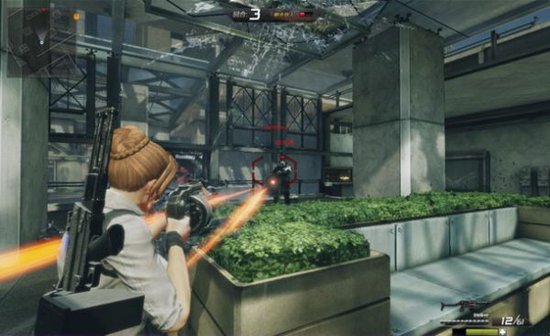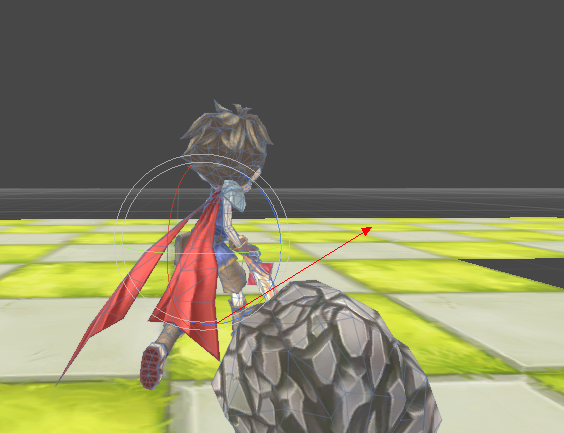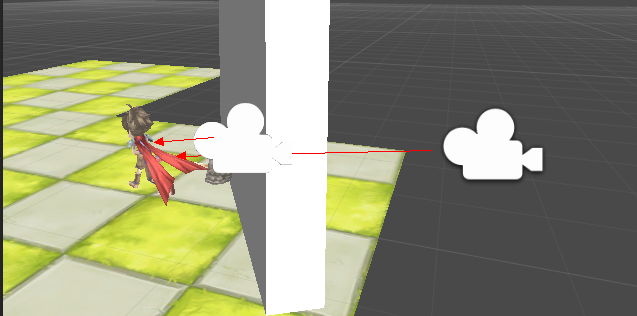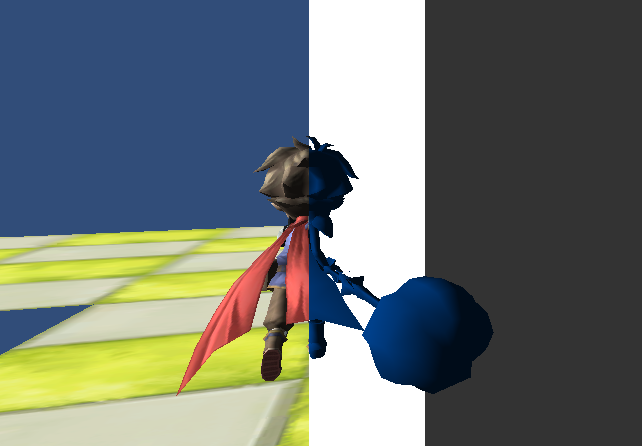TPS相機及相機遮擋的一些處理方法
提要
第三人稱相機有非常多種,今天要實現的一個第三人稱射擊遊戲的相機。
如果對相機控制不是很瞭解,建議看一下上一篇博文 FPS相機。
控制思路
滑鼠控制yaw和pitch,新增一個distance變數來記錄角色和相機之間的距離。通過yaw和pitch來得到相機的position。
最後新增一個向右的位移和向上的位移量,將角色放在螢幕偏左邊的位置。
transform.localEulerAngles = new Vector3(-rotationY, rotationX, 0); characterModel.transform.forward = new Vector3(transform.forward.x, characterModel.transform.forward.y, transform.forward.z); target.forward = new Vector3(transform.forward.x, 0, transform.forward.z); float yaw = rotationX; float pitch = rotationY; float yawRed = Mathf.Deg2Rad * (yaw - 90f); float pitchRed = Mathf.Deg2Rad * pitch; Vector3 direction = new Vector3(-Mathf.Cos(yawRed) * Mathf.Cos(pitchRed), -Mathf.Sin(pitchRed), Mathf.Sin(yawRed) * Mathf.Cos(pitchRed)); transform.position = target.transform.position + distance * direction; transform.position += transform.right + transform.up;
在這裡,相機只控制了model的rotation。
direction是通過yaw和pitch計算出的角色到相機的Ray的方向。
一些問題的處理
角色往斜方向跑的動畫處理
通常在TPS遊戲中,角色的背面是始終對著攝像機的。當玩家希望角色往斜方向走的時候,不能直接播放角色往前走的動畫,這時候就需要給角色Model一個額外的角度偏移量,這個偏移量由玩家的輸入決定。
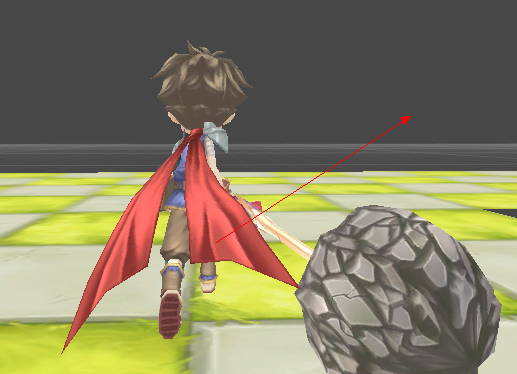
程式碼如下
characterModel.transform.forward = new Vector3(transform.forward.x, characterModel.transform.forward.y, transform.forward.z); if (characterModel.transform.parent.GetComponent<Character>().characterFPAnimation.extraRotation == 0) { extraRot = Mathf.Lerp(extraRot, 0f, 10 * Time.deltaTime); }else { extraRot = Mathf.Lerp(extraRot, characterModel.transform.parent.GetComponent<Character>().characterFPAnimation.extraRotation, 10 * Time.deltaTime); } Quaternion targetRotation = characterModel.transform.rotation * Quaternion.AngleAxis(extraRot, Vector3.up); characterModel.transform.rotation = targetRotation;
添加了Lerp,讓轉身更加順滑。
牆體遮擋
環境遮擋是第三人稱攝像機一個經常遇到問題,下面是幾個常見的方法。
解法一 射線檢測,將相機移動到不被遮擋的位置。
在Unity官網的一個Tutorial裡面,處理的方法是將相機慢慢上移,直到看到角色(遊戲的場景是沒有天花板的)
bool ViewingPosCheck (Vector3 checkPos) { RaycastHit hit; // If a raycast from the check position to the player hits something... if(Physics.Raycast(checkPos, player.position - checkPos, out hit, relCameraPosMag)) // ... if it is not the player... if(hit.transform != player) // This position isn't appropriate. return false; // If we haven't hit anything or we've hit the player, this is an appropriate position. newPos = checkPos; return true; } void SmoothLookAt () { // Create a vector from the camera towards the player. Vector3 relPlayerPosition = player.position - transform.position; // Create a rotation based on the relative position of the player being the forward vector. Quaternion lookAtRotation = Quaternion.LookRotation(relPlayerPosition, Vector3.up); // Lerp the camera's rotation between it's current rotation and the rotation that looks at the player. transform.rotation = Quaternion.Lerp(transform.rotation, lookAtRotation, smooth * Time.deltaTime); }
在Update裡面的處理是這樣的
void FixedUpdate ()
{
// The standard position of the camera is the relative position of the camera from the player.
Vector3 standardPos = player.position + relCameraPos;
// The abovePos is directly above the player at the same distance as the standard position.
Vector3 abovePos = player.position + Vector3.up * relCameraPosMag;
// An array of 5 points to check if the camera can see the player.
Vector3[] checkPoints = new Vector3[5];
// The first is the standard position of the camera.
checkPoints[0] = standardPos;
// The next three are 25%, 50% and 75% of the distance between the standard position and abovePos.
checkPoints[1] = Vector3.Lerp(standardPos, abovePos, 0.25f);
checkPoints[2] = Vector3.Lerp(standardPos, abovePos, 0.5f);
checkPoints[3] = Vector3.Lerp(standardPos, abovePos, 0.75f);
// The last is the abovePos.
checkPoints[4] = abovePos;
// Run through the check points...
for(int i = 0; i < checkPoints.Length; i++)
{
// ... if the camera can see the player...
if(ViewingPosCheck(checkPoints[i]))
// ... break from the loop.
break;
}
// Lerp the camera's position between it's current position and it's new position.
transform.position = Vector3.Lerp(transform.position, newPos, smooth * Time.deltaTime);
// Make sure the camera is looking at the player.
SmoothLookAt();
}從角色的腳到頭,分四個地方都進行了射線檢測,最後的結果是這樣的

類似的還可以將相機拉到被遮擋的牆前面。
檢測的程式碼如下
void ShelterTest()
{
RaycastResult result = new RaycastResult();
float characterHeight = GameManager.GetInstance().character.height * 0.4f;
Vector3 targetHeadPos = new Vector3(target.position.x, target.position.y + characterHeight, target.position.z);
Ray[] testRays = new Ray[5];
testRays[0] = new Ray(targetHeadPos, transform.position + 0.8f * transform.right + 0.5f * transform.up - targetHeadPos);
testRays[1] = new Ray(targetHeadPos, transform.position + 0.8f * transform.right - 0.5f * transform.up - targetHeadPos);
testRays[2] = new Ray(targetHeadPos, transform.position - 0.8f * transform.right + 0.5f * transform.up - targetHeadPos);
testRays[3] = new Ray(targetHeadPos, transform.position - 0.8f * transform.right - 0.5f * transform.up - targetHeadPos);
testRays[4] = new Ray(transform.position, transform.position - targetHeadPos);
float castDist = (transform.position - targetHeadPos).magnitude;
float[] dists = new float[5];
for (int i = 0; i < 5; i++)
{
if (RaycastHelper.RaycastAll(testRays[i], castDist, true, GameManager.GetInstance().character.floorMask, out result))
{
Debug.DrawLine(targetHeadPos, result.point, Color.red);
dists[i] = Vector3.Distance(result.point, targetHeadPos);
}else
{
Debug.DrawLine(targetHeadPos, targetHeadPos + castDist * testRays[i].direction, Color.blue);
dists[i] = castDist;
}
}
float minDist0 = Mathf.Min(dists[0], dists[1]);
float minDist1 = Mathf.Min(dists[2], dists[3]);
float minDist2 = Mathf.Min(minDist0, minDist1);
float minDist = Mathf.Min(minDist2, dists[4]);
transform.position = targetHeadPos + minDist * testRays[4].direction.normalized;
}用了5根射線來檢測,為了避免fov穿牆的問題。注意是從角色射向攝像機。
解法二 半透明掉中間遮擋的物體
用raycast進行檢測,然後動態替換掉材質就可以了。
解法三 利用Stencil對角色進行重繪
對Stencil Buffer 不瞭解的請參考這一篇 : Stencil buffer
通過Ztest將角色被遮擋部分的Stencial標記出來,然後就可以對這部分的畫素進行處理。要麼用一種單色繪製出來,要麼繪製成透明,要麼繪製一個發光的描邊,都可以。
簡單的效果如下:
這裡分三個pass處理,第一遍繪製利用ZTest寫Stencil
Shader "Custom/Player" {
Properties {
_MaskValue("Mask Value", int) = 2
_MainTex ("Base (RGB)", 2D) = "white" {}
}
SubShader {
Tags { "RenderType"="Opaque" }
LOD 200
Stencil {
Ref [_MaskValue]
Comp always
Pass replace
ZFail keep
}
CGPROGRAM
#pragma surface surf Lambert
sampler2D _MainTex;
struct Input {
float2 uv_MainTex;
};
void surf (Input IN, inout SurfaceOutput o) {
half4 c = tex2D (_MainTex, IN.uv_MainTex);
o.Albedo = c.rgb;
o.Alpha = c.a;
}
ENDCG
}
FallBack "Diffuse"
}
再加一個Shader來清掉ZTest
Shader "Custom/ClearZbuffer" {
Properties {
_MainTex ("Base (RGB) Gloss (A)", 2D) = "white" {}
}
SubShader {
Tags { "RenderType"="Transparent" "Queue"="Transparent+100"}
LOD 80
ColorMask 0
ZTest Greater
ZWrite On
CGPROGRAM
#pragma surface surf Lambert
sampler2D _MainTex;
struct Input {
float2 uv_MainTex;
};
void surf (Input IN, inout SurfaceOutput o) {
half4 c = tex2D (_MainTex, IN.uv_MainTex);
o.Albedo = half4(1,0,0,1);
o.Alpha = 0.3;
}
ENDCG
}
FallBack "Diffuse"
}
最後用一個Shader對被Stencil標記出來的畫素進行處理
Shader "Custom/StencilTransparent" {
Properties {
_MaskValue("Mask Value", int) = 2
_MainTex ("Base (RGB)", 2D) = "white" {}
_TransVal ("Transparency Value", Range(0,1)) = 1.0
_ColorAdd ("Color (Add, RGB)", Color) = (0.5,0,0)
}
SubShader {
Tags { "RenderType"="Opaque" "Queue"="Transparent+100"}
LOD 80
Stencil {
Ref [_MaskValue]
Comp notequal
Pass keep
}
ZTest LEqual
ZWrite On
Blend SrcAlpha OneMinusSrcAlpha
BlendOp Add
CGPROGRAM
#pragma surface surf Lambert
sampler2D _MainTex;
fixed _TransVal;
half4 _ColorAdd;
struct Input {
float2 uv_MainTex;
};
void surf (Input IN, inout SurfaceOutput o) {
half4 c = tex2D (_MainTex, IN.uv_MainTex);
//o.Albedo = c.rgb * half4(1,0,0,1);
//o.Alpha = 1;
o.Albedo = c.rgb * _ColorAdd;
o.Alpha = _TransVal;
}
ENDCG
}
FallBack "Diffuse"
}
參考
Real-Time Cameras:A Guide for Game Designers and Developers
Unity tutorial stealth - http://unity3d.com/learn/tutorials/projects/stealth-tutorial-4x-only

